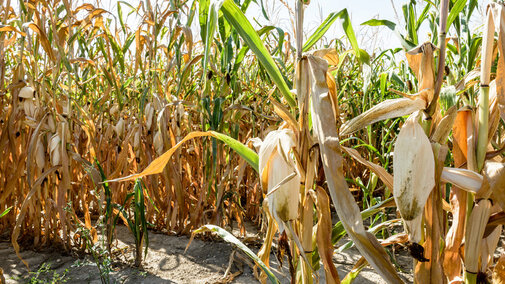Volunteer Wheat Management
When rainfall is lacking, livestock producers sometimes need to be creative on how to stretch their forage resources. One option might be to graze volunteer wheat fields while still being a “good neighbor” to nearby grain farmers who are protecting potential wheat grain yields for the upcoming growing season.
Generally, when wheat fields are hailed during the grain fill period, there is a high probability that volunteer wheat plants will grow from the shattered grain seeds. These volunteer plants can then provide “live green bridge” for feeding wheat curl mites, which may then vector the wheat streak mosaic disease into newly emerging wheat fields drilled in the fall.
The challenge for livestock producers is that some crop advisors recommend controlling volunteer wheat soon after harvest to break the green bridge. This concept can be misleading, since wheat curl mites can also survive on other wild grass species such as barnyardgrass, some foxtails and even later planted green corn fields. So, growers focusing only on killing volunteer wheat plants early or soon after harvest may be limiting supplemental forage growth for livestock feed while still not effectively controlling the curl mites.
To prevent neighborhood feuds over when to control volunteer wheat, the compromise is managing the wheat curl mites’ life cycle. Since curl mites cannot survive without a live plant food source for more than two weeks, the best strategy for protecting the next wheat production crop is to assure that all volunteer wheat, grassy weeds and late planted corn fields are dead (dry) (two weeks prior to wheat emergence) within a half mile of newly drilled wheat fields this fall.
Following this strategy, the volunteer can be used as an alternative forage for livestock producers. Then, neighbors can cooperatively time their herbicide applications and grassy weeds control to starve the wheat curl mites and not allow them to move from green field to neighboring green field.
Other best management practices for managing wheat streak mosaic include drilling wheat varieties with high resistance to mosaic disease, avoiding (early wheat planting) delaying drilling until after the Hessian fly free fall date, and following crop rotations.
Summer Heat and Forage Growth
As most of the state is experiencing unusually hot temperatures this summer, we need to consider how these temperatures affect our pasture and forage plants.
The two primary plant classifications are warm-season and cool-season and this is based on basic plant physiology and their specific photosynthetic pathway. Practically speaking, and as their names suggest, every plant species has a specific temperature range in which it maintains growth.
When it gets hot — 90-plus degrees — cool-season plants such as bromegrass, orchardgrass, fescues, needlegrasses and wheatgrasses all struggle and will have a very slow growth rate, even if there is plenty of moisture. With the dry conditions this summer, these cool-season grasses have likely completely stopped growth and have gone into a summer dormant state.
Warm-season grasses are just the opposite. Millet, sudangrass, sorghums and our native bluestems, gramas, switchgrass and other warm-season grasses thrive when the temperature is around 90 degrees. Their metabolism runs at peak efficiency when it is hot, so they grow rapidly while maintaining reasonable forage quality and good root growth. With drought conditions, also be aware of the potential for the seeded summer annual grasses to accumulate nitrates.
As you graze or hay, be aware of the stress weather is putting on your forage. When it’s too hot, allow plants a longer recovery period before the next grazing. And don’t expect high feed values or good animal gains when the nutritional goodies are burned right out of the plants.
Proper expectations and management adjustments can limit the stress from hot weather.
Drought-stressed Corn Options: Haying, Silage, Baleage or Grazing
By Brad Schick
Many areas of Nebraska and surrounding states are experiencing drought and lack of water for irrigation. What are the alternatives and considerations when corn grain harvest won’t be a viable option?
First, before any actions are taken, file an insurance claim or discuss the options with your crop insurance agent on what is permitted, as well as what strips need to be left.
Another important item is to check the labels of any chemicals applied to the corn and look for any grazing, haying or harvesting restrictions if it is to be used for livestock feed.
If deciding what method to create feed, remember that typical dry haying does not reduce the nitrate level. However, silage, or any ensiling process such as baleage can reduce the level of nitrates 20-50%. The lower portion of the plant contains the highest concentration of nitrates. Do NOT harvest for at least three days following rain that “breaks” drought conditions. The rain causes an uptake of nitrogen from the soil, which is translocated into the plant. When feeding forages with higher nitrates, be sure to dilute with other feeds to reach safe feeding levels.
For hay, dry matter content needs to be about 85%. Baleage dry matter content should be 45-55% while a typical packed silage should be 30-35%.
When cutting for hay, baleage or silage, leave six to eight inches of stalk above the ground surface to avoid including the highest nitrate concentrations. Corn should be heavily crimped, if possible. Baleage will likely need to be wilted for several hours to reach the correct and safe moisture content.
The use of an inoculant is a good risk management tool to ensure a higher quality silage and lack of spoilage.
If grazing drought-stressed corn, strip graze to limit access from both a grain and nitrate risk standpoint. Adapt cattle to grain and turn cattle out that are full, with plenty of fresh water.

